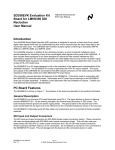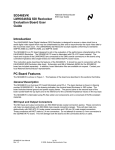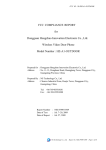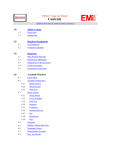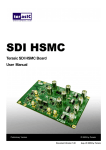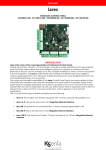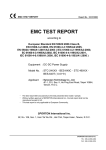Download SD356EVK Evaluation Kit Board for LMH0356 SDI Reclocker User
Transcript
SD356EVK Evaluation Kit Board for LMH0356 SDI Reclocker User Manual National Semiconductor EVK User Manual Introduction The LMH0356 Serial Digital Interface (SDI) reclocker is designed to recover a clean clock from a serial digital video signal which may be contaminated by jitter and to resynchronize the input video data to the recovered clean clock. The LMH0356 SDI reclocker accepts signals conforming to standards SMPTE 259M (C), SMPTE 292M, and SMPTE 424M. The LMH0356 includes, in addition to the reclocking circuitry, an input 4-channel multiplexer which permits selection for reclocking of any of four serial digital video signals at the inputs of the LMH0356. It also includes fixed equalizers on its inputs designed to reduce the inter-symbol interference (ISI) generated by dispersive PC board traces between the serial digital video source and the reclocker inputs. The LMH0356 fixed equalizers are designed to compensate for the frequency-dependent loss of up to 30 inches of FR-4 PC board trace. The SD356EVK is a PC board designed to aid in the evaluation of the performance characteristics of the LMH0356 reclocker. The SD356EVK PC board is fabricated with FR-4 PC board material. The inputs and outputs of the LMH0356 are connected to the SMA coaxial connectors on the board using controlledimpedance 50Ω single-ended and 100Ω differential PC board traces. This instruction manual describes the features of the SD356EVK. It should be used in conjunction with the LMH0356 SDI reclocker data sheet. Schematics and PC board layout drawings for the SD356EVK board are included separately. In addition, board fabrication files are available on request. Contact your local National Semiconductor representative. PC Board Features The SD356EVK is shown in Figure 1. The features of the board are described in the sections that follow. General Description The SD356EVK is a four-layer PC board fabricated using FR-4. The layer stackup is shown in drawing number 980600057-001. As the drawing indicates, the nominal board thickness is .062 inches. The board includes internal ground and power supply planes. The ground plane is the second layer of the board (underneath the top layer) and is the reference for the controlled-impedance traces on the top layer. The SD356EVK is fabricated using Pb-free solder and components and is comprised of RoHS-compliant materials. SDI Input and Output Connectors The SDI input and output connectors are 50Ω SMA female coaxial connectors (jacks). These connectors will mate non-destructively with 50Ω SMA male coaxial connectors (plugs). They will also mate nondestructively with 50Ω APC-3.5 male coaxial connectors and 2.92 mm (K) male coaxial connectors. These connectors will NOT mate to 2.4 mm connectors. Do not attempt to connect 2.4 mm connectors to the SD356EVK PC board. This will damage both the board and the connected device or cable. SD356EVK User Manual Rev 1.0 1 of 11 © 2008, National Semiconductor Corp. SDI Input Connectors (50Ω SMA) 30-inch FR4 Trace (Input SDI0) Control/Indicator LEDs 15-inch FR4 Trace (Input SDI1) DC Power Connectors External Control Header Control DIP Switches Control Headers SMBus Connector (not active) SDI Output Connectors (50Ω SMA) 27 MHz Reference Crystal LMH0356 SDI Reclocker 30-inch FR4 Trace (Test Coupon) 27 MHz Reference External Input Figure 1. SD356EVK board Although the SMA coaxial connectors are ruggedized for attachment to the edge of the SD356EVK PC board, they can be damaged by over-tightening them. A standard SMA torque wrench with a torque limitation of 7-10 in-pounds should always be used to connect cables to the connectors on the SD356EVK. Do not allow heavy cables to hang unsupported from the connectors as they may break off the board. SD356EVK User Manual Rev 1.0 2 of 11 © 2008, National Semiconductor Corp. The SDI input and output connectors occur in pairs as the inputs and outputs of the LMH0356 SDI reclocker are differential. It is not necessary to terminate unused inputs. Both the inputs and outputs of the LMH0356 SDI reclocker are internally terminated. The SD356EVK has two sets of outputs connected to the two outputs of the LMH0356 SDI reclocker. The first set of outputs, labeled SDO, always carry the digital video data signal unless they are muted. If the reclocker is locked and not bypassed, these outputs carry a reclocked version of the input signal. If the reclocker is unlocked or bypassed, these outputs carry an unmodified replica of the input signal. The outputs may be muted by the output mute control described in a later section. The second set of outputs of the SD356EVK, labeled SCO/SDO2, can be set either to output a copy of the data on the first set of outputs, either reclocked or not as describe above, or to output the recovered clock signal from the LMH0356 SDI reclocker. The clock signal is only available when the LMH0356 SDI reclocker is locked to a valid input signal. The inputs and outputs of the SD356EVK PC board are AC-coupled with 1 µF 0402-size coupling capacitors. These capacitors are rated for 10 VDC working voltage. The inputs and outputs of the SD356EVK board may be terminated in any DC voltage that does not exceed this 10 V limit relative to the negative power supply. The coupling capacitors may be replaced with 0402-size 0Ω resistors for DCcoupled evaluation. FR-4 Traces Two of the inputs to the SD356EVK, inputs SDI0 and SDI1, are equipped with long FR-4 test traces. The trace lengths are 30 inches and 15 inches respectively on the two inputs. The other two inputs are coupled to the LMH0356 SDI reclocker through very short FR-4 traces. The FR-4 test traces are meant to demonstrate the action of the input passive equalizers. The input passive equalizers compensate for the ISI introduced by long PC board traces. The SD356EVK demonstrates that the performance of the LMH0356 SDI reclocker is unaffected by up to 30 inches of lossy FR-4 trace on its inputs. The SD356EVK also includes a 30 inch FR-4 test trace which can be used to evaluate the ISI effect introduced by such a trace. If desired, connectors can be soldered on to this test trace and the ISI can be measured by external test equipment. If this is desired, the same connectors used on the inputs and outputs of the SD356EVK may be used. These connectors are specified in the bill of materials for the SD356EVK. DC Power Connectors DC power is applied to the SD356EVK by means of standard .175-inch diameter binding posts. Three power supply terminals are provided. The first is a common ground, to which the negative supply voltage should be connected. This is the black binding post on the board. The two red binding posts on the board are meant to provide 3.3 VDC to 1) the LMH0356 SDI reclocker alone, and 2) the remainder of the circuitry on the SD356EVK board. The dual-supply configuration permits measurement of the current drawn by the LMH0356 SDI reclocker independent of the other devices on the board if desired. The two supplies may be connected together if desired using either an external jumper or the onboard header between the 3.3 V power supply terminals. The power supply is not regulated on the SD356EVK board so the effects of power supply variations can be evaluated. It is recommended that the maximum supply voltage rating of the LMH0356 (4 VDC) not be exceeded. The LMH0356 SDI reclocker can be powered-down using its enable feature. This feature is accessible through the control inputs described in the next section. The dual-supply configuration of the SD356EVK can be used to observe the effect on supply current of powering down the LMH0356. Controls and Indicators The control lines of the LMH0356 SDI reclocker can be controlled by various means using the SD356EVK. The primary method for controlling these lines is the DIP switches located on the SD356EVK board. The DIP switches are labeled according to their function. When the switch actuator is pushed to the right SD356EVK User Manual Rev 1.0 3 of 11 © 2008, National Semiconductor Corp. (seen from the top), the switch is closed. The schematic for the board indicates the functions of each switch. The switch functionality is summarized in Table 1 below. Two headers are also provided for operating the control lines of the LMH0356 SDI reclocker. The first is located immediately below the DIP switches. This header is meant to be used with two-pin jumpers and provides parallel functionality to the DIP switches. When a jumper is installed on the header it overrides the function of the equivalent DIP switch. The second header is located to the right of the DIP switches. This header is meant to provide access for remote control of the LMH0356 SDI reclocker. When this header is used the DIP switches should all be set in the open position and no jumpers should be installed on the control header. The connections for this header are described in the schematic for the SD356EVK PC board. It is recommended that this header only be used for advanced control applications and only by users familiar with the operation of the LMH0356 SDI reclocker. LED indicators are provided near the top of the board to indicate the state of the control inputs and the indicator outputs of the LMH0356 SDI reclocker. The LED states and their meanings are summarized in Table 1. SD356EVK User Manual Rev 1.0 4 of 11 © 2008, National Semiconductor Corp. Function Input Select Rate Select Bypass/Autobypass Table 1. Control and Indicator Function Summary Switch Indicator Switch “On” Function and Indication Sel0 Sel1 Sel0 Sel1 Rate0 Rate1 Rate0 Rate1 Bypass/Autobypass Bypass Switch “Off” Function and Indication Select line pulled to logic 1 Select line pulled to logic 0 Indicator light turns red Indicator light turns green Rate line pulled to logic 1 Rate line pulled to logic 0 Indicator light turns red Indicator light turns green LMH0356 reclocker forced to bypass mode LMH0356 reclocker in normal (autobypass) mode Indicator on (red) Indicator off Output Mute OP Mute None LMH0356 reclocker output is muted LMH0356 reclocker output is active Serial Clock Output Enable SCO_EN SCO_EN Second output of the SD356EVK outputs the recovered clock Second output of the SD356EVK outputs a copy of the reclocked data Indicator on (green) Chip Enable ENABLE ENABLE Indicator off LMH0356 is powered up (active) LMH0356 is powered down (inactive) Indicator on (green) Indicator off SD/HD Indication None SD_HD Indicator green indicates HD or 3 Gb/s signal or no signal detected Indicator red indicates SD signal detected Lock Detection None LOCK DET Indicator on (green) when the LMH0356 reclocker is locked to the incoming signal Indicator off when the LMH0356 reclocker is not locked to the incoming signal SD356EVK User Manual Rev 1.0 5 of 11 © 2008, National Semiconductor Corp. There is also a header on the right side of the SD356EVK board which is connected to the SD/HD indication of the LMH0356 SDI reclocker. It is meant to control an LMH0302 SDI cable driver. The output polarity of the signal on this header is such that it can be connected directly to the SD/HD control input of the LMH0302 cable driver. The header on the SD356EVK board facilitates this connection. 27 MHz Reference The SD356EVK includes an on-board 27-MHz reference crystal. In the normal configuration of the board this crystal is active. The LMH0356 SDI reclocker includes a crystal driver circuit that produces the 27MHz reference clock using this crystal. The SD356EVK also includes a connector for inputting an external 27-MHz reference if desired. In order to disable the on-board crystal a 0Ω resistor indicated on the schematic for the board must be removed. This permits evaluation of the operation of the LMH0356 SDI reclocker with an external reference. SMBus Connector The LMH0356 SDI reclocker can be controlled via a 2-wire bus very similar to the standard SMBus. This mode of operation is reserved for factory use only. Typical Output Waveform A test waveform can be readily generated and used to verify proper operation of the SD356EVK. In order to generate this output waveform, the following setup procedure should be used. Test Setup The test setup used for testing the SD356EVK board is shown in Figure 2. Note that the test setup includes a SyntheSys Research BERTScope as a signal generator, eye diagram measurement device, and bit error rate test receiver. Other equivalent instruments could be used for thse measurements. The equipment used for testing the SD356EVK is listed in Table 2. SD356EVK User Manual Rev 1.0 6 of 11 © 2008, National Semiconductor Corp. UTIFlex Cable CK+ CK- BERTScope Clock In Clock Out Data Out Data In Data+ Data- Data+ Data- UTIFlex Cable UTIFlex Cable UTIFlex Cable UTIFlex Cable SD356 EVK Board SDI0 SDO SDI0 SDO SCO UTIFlex Cable SCO VCC_IC VCC 3.3 V GND SMBus + GND RF In HP E3610A DC Power Supply SMBus Controller Cable HP8593E Spectrum Analyzer ` PC with SMBus Controller and Serial Port Figure 2. Test setup for the SD356EVK board. SD356EVK User Manual Rev 1.0 7 of 11 © 2008, National Semiconductor Corp. To generate the example output eye diagram shown, the PC and the spectrum analyzer are not required. These items are used for other elements of the test procedure. Description Table 2. Test Equipment and Material Required Suggested Equipment Manufacturer Bit Error Rate Test Set with the following: Model Number BERTScope 12500B J-Bert N4903A Hewlett-Packard DC Power Supply E3610A Spectrum Analyzer with minimum 3 GHz bandwidth Hewlett-Packard Portable Spectrum Analyzer 8593E Six (6) each UTIFlex coaxial cables Micro-Coax Inc. UTIFlex UFB205A0-0360000000 3 Gb/s Serial Data Capability SyntheSys Research Equipment Name Agilent Technologies Jitter Injection Capability Eye Diagram and Jitter Measurement Capability DC Power Supply 3.3 V @ 0.5 A SMA connectors 36 inch length SD356EVK User Manual Rev 1.0 8 of 11 © 2008, National Semiconductor Corp. Test Equipment Settings The example eye diagram shown is for a 1.4835 Gb/s HD SDI signal. Similar eye diagrams can be obtained at 2.97 Gb/s and at 270 Mb/s by changing the bit rate setting on the signal generator. Generator Setting Value Comments Data Rate 1.4835 Gb/s Any valid SMPTE data rate supported by the LMH0356 SDI reclocker can be used. These rates are 270 Mb/s, 1.485 Gb/s, 1.4835 Gb/s, 2.967 Gb/s, and 2.97 Gb/s Data Pattern PRBS-7 This is a standard pseudorandom pattern 127 bits long. Other pseudorandom patterns can be used as well as live SDI video patterns (which are not, in general, pseudorandom) or the SMPTE pathological data sequences. Output Amplitude 200 mV This is the specified lower limit for the input differential voltage for the LMH0356. Higher input voltages can be used. A differential input voltage of 200 mV peak-to-peak means that each of the two inputs swings 100 mV peak-to-peak. Output Offset 0V The inputs of the SD356EVK are AC coupled so the output offset of the generator does not matter unless it overstresses the input coupling capacitors. Do not exceed 4 V output offset on the generator to avoid this. Injected Jitter 0 UI If the signal generator is capable of injecting controlled jitter, the jitter tolerance of the LMH0356 may be evaluated using the SD356EVK board. Typical settings used for jitter tolerance testing on the SD36EVK board are 0.7 UI jitter amplitude at 5 MHz and 10 MHz jitter frequencies. SD356EVK User Manual Rev 1.0 9 of 11 © 2008, National Semiconductor Corp. SD356EVK Board Settings Essentially all of the settings of the SD356EVK are set to their nominal values to produce the typical eye diagram shown in Figure 3. Table 3. Control Settings and Indicator States to Produce Typical Eye Diagram Function Switch Indicator Switch and Comments Indicator State Input Select Sel0 Sel1 Sel0 Sel1 Both switches off Rate0 Rate1 Rate0 Rate1 Both switches off Bypass/Aut obypass Bypass Switch off Output Mute OP Mute None Switch off LMH0356 reclocker output is active. Serial Clock Output Enable SCO_EN SCO_EN Switch off Indicator light off This test will produce the same results regardless of the state of the SCO_EN. Chip Enable ENABLE Switch of LMH0356 is powered up. Rate Select Bypass/Autobypass Both indicator lights green Both indicator lights green Indicator light off ENABLE This is the setting for selecting input SDI0. Other selection settings can be used with other SDI inputs. This is the setting for automatic rate detect. The rate selection switches can also be set to match the data rate input. For a 1.4835 Gb/s signal as described here, Rate0 can be off and Rate 1 on. LMH0356 reclocker in normal (autobypass) mode. Indicator light on SD/HD Indication None SD_HD Indicator green, indicating HD or 3 Gb/s signal or no signal detected The indicator will be red if a 270 Mb/s signal is used. Lock Detection None LOCK DET Indicator on (green), indicating that the LMH0356 reclocker is locked to the incoming signal The indicator will be off if a non-supported data rate is used. SD356EVK User Manual Rev 1.0 10 of 11 © 2008, National Semiconductor Corp. Sample Output Eye Diagram The output eye diagram shown in Figure 3 is typical of the output eye diagrams obtained during testing of the SD356EVK. Figure 3. Typical output eye diagram for 1.4835 Gb/s. Summary The SD356EVK is a simplified four-layer PC board designed to facilitate the evaluation of the LMH0356 SDI reclocker. In concept it is a simple input/output board with the LMH0356 SDI reclocker in the signal path. This manual has described the features of the PC board and its operation. Please also see the SDI Feature site at:: www.national.com/sdi SD356EVK User Manual Rev 1.0 11 of 11 © 2008, National Semiconductor Corp. Mouser Electronics Authorized Distributor Click to View Pricing, Inventory, Delivery & Lifecycle Information: Texas Instruments: SD356EVK/NOPB












